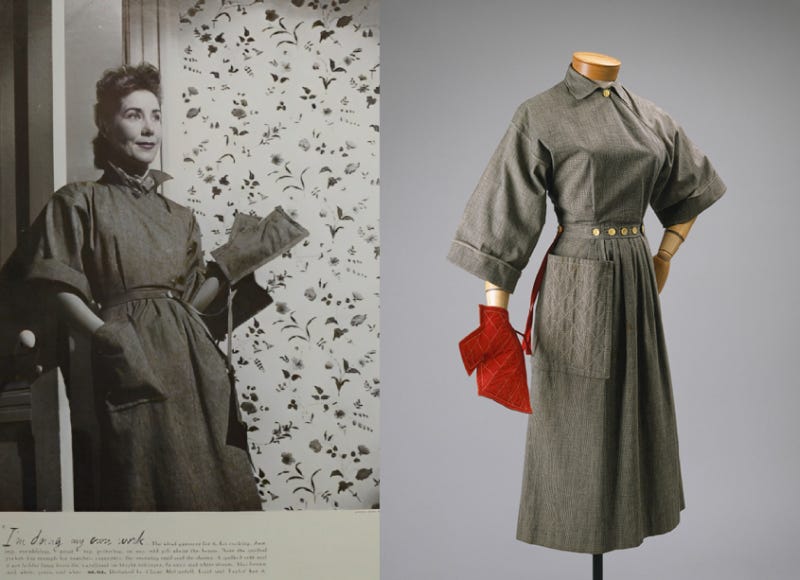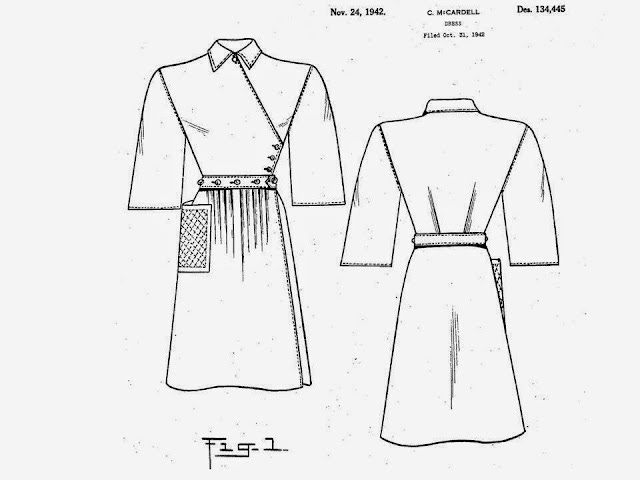Sporty oven mitts & the history of everything
A little fashion history rabbit hole, plus my textiles and tech reading list
Earlier this week, when I was looking up some 1940s garment silhouettes for a different project, I came across an image of Claire McCardell’s 1942 “Pop-over”1 dress.

I was struck immediately by the modern-feeling silhouette, the button placement, and the giant wonderful patch pocket! With the nipped waist and wide sleeves, it has VERY similar vibes to Noble’s utility dress, a slow fashion staple that has spawned many indie sewing2 dupes. And the wrap element also has a ton of modern iterations. Everything new is old and all that.


Interestingly, McCardell received a patent for the design of the dress. Apparel patents were more common in the 1940s, comprising 16.6% of all patents (versus 3.6%) today3. Because it was classified as a “utility garment” during World War II, the manufacturer was able to make a special deal on the labor to produce the dress, and could therefore price it at just $6.95. It was wildly popular, and over 75,000 were sold.

When I came across the image of the dress with the red oven mitt, I at first thought it was some sort of unfamiliar old timey sporting equipment, as the “Pop-over” is often described as “sporty” and “utilitarian.” But no, the oven mitt is just a oven mitt. It came attached to the dress.
Fashion history is a topic I’m very interested in, but currently don’t know much about. When I set out to articulate the focus of Digital Seam Ripper—"deconstructing the intersections of textiles & tech”—I intentionally went with something quite broad, with plenty of room to explore topics I want to spend more time thinking, reading, and writing about. I started this newsletter in part to direct my self-education in a set of things I find myself always sort of mulling over in the background: fiber crafts, industrial history through a social lens, trend cycles and personal style, textile innovations, the puzzle of personal responsibility and structural change within the climate crisis, how to build a meaningful and creative life, etc. You know, just the little things!
So as part of this self-education, I have a reading list. It’s always evolving and growing, but here are some of the books I’m using to guide my inquiry.
Already Read
Blood in the Machine: The Origins of the Rebellion Against Big Tech by
. Before I read this book, I was aware of some of the connections between early computing and textiles, like the Jacquard loom’s punch cards as inspiration for running programs in Charles Babbage and Ada Lovelace’s Analytical Engine. But I knew hardly anything about the Luddite Rebellion, and hadn’t thought deeply about what was at stake during the industrialization of the textile trades. This book led me to so many galaxy brain moments that have really shaped my thinking in the year since I read it.Threads of Life: A History of the World Through the Eye of a Needle by Clare Hunter. I listened to the audio book of this at the end of last year4, and found Hunter’s storytelling about different episodes in sewing and embroidery history to be deeply immersive. A number of the pieces I have planned for the newsletter this year were inspired by things I learned in Threads of Life.
Consumed: The Need for Collective Change: Colonialism, Climate Change, and Consumerism by Aja Barber. I’ve long followed Barber online (Patreon, Instagram), and this book builds on the themes of hyper-consumption she explores there. I especially loved the chapter on the textile waste cycle as colonial legacy.
Broad Band: The Untold Story of the Women Who Made the Internet by Claire L. Evans. I read this a few years ago and frequently revisit individual chapters on the computing pioneers featured in the book.
Hidden Figures: The American Dream and the Untold Story of the Black Women Mathematicians Who Helped Win the Space Race by Margot Lee Shetterly. Another “Untold Story” about women in STEM! It’s almost like the contributions of women, particularly Black women, in a male-dominated field have been systematically ignored. This book is a breathtaking piece of research. Shetterly paints the details of these women’s lives in such rich detail.
Butts: A Backstory by Heather Radke. Okay so obviously this book has the best title, like, ever. But it’s also quite a serious cultural history of the backside, beginning with the brutal story of Sarah Baartman. Particularly relevant to my interests was a section on jeans fit models and the shifting emphasis and de-emphasis of the butt in fashion silhouettes.
To Read
How to Read a Dress: A Guide to Changing Fashion from the 16th to the 21st Century by Lydia Edwards
Worn: A People's History of Clothing by Sofi Thanhauser
Craft is Political, edited by D Wood
Secondhand: Travels in the New Global Garage Sale by Adam Minter
The Fabric of Civilization: How Textiles Made the World by Virginia Postrel
The Golden Thread: How Fabric Changed History by Kassia St. Clair
Women's Work: The First 20,000 Years by Elizabeth Wayland Barber
Zeros and Ones: Digital Women and the New Technoculture by Sadie Plant
The One Device: The Secret History of the iPhone by Brian Merchant
What else do you think should be on my list? What are your non-fiction faves on fashion, textiles, and industrial history? A bunch of the recommendations above came from when I asked this same question on Instagram a few months ago, and I’d love to keep crowdsourcing my reading list. Right now I’m specifically seeking book recommendations, but I’ll likely do a future post on other media like podcasts and newsletters.
As you can see, I really gravitate toward “history of the world” type books. I want to know EVERYTHING, and fast. But I’d like to add more deep dives as well.
So named because it was intended to be “popped over” more delicate or precious dresses while doing housework, though the dress became a very popular piece when worn on its own.
Speaking of indie sewing, while I was working on this piece I saw a note here on Substack by
on drafting a dress based on another of McCardell’s wrap designs from the same era. So cool!I read this stat on this blog, which then led me down a rabbit hole on patent classes on the The United States Patent and Trademark Office website. There’s something I find so charming about the terse, precise language of patenting. For example, this is the description of a muff (subclass 611 under class D2—APPAREL AND HABERDASHERY): “Design for cylindrical unit, open at both ends into which the hands are placed for warmth.” Just a perfect little poem.
I’m finding that for non-fiction, I like to first listen to the audio book via Libby, then buy a print copy to re-read and refer back to certain sections.




We have quite a bit of interest overlap! I'm currently reading Worn by Sofi Thanhauser and thinking through how I might regurgitate what I've been learning about textile production pre and post industrial revolution. One of my favorite tidbits so far has been the myth that Samuel Slater illegally snuck blueprints of British machinery into the US in the lining of his jacket. Fact checking shows it's probably not true, but what a story, eh? :)
Excited to see the other books on your list and adding them to my own. I've been working through Unraveled: The life and Death of A Garment for a while now, not sure I can recommend it since it hasn't been super captivating, but she explores modern production and environmental impact.
Thanks for the recs! The Blood in the machine and threads of life audio books are available on Libby at my library right now 🙌🏻